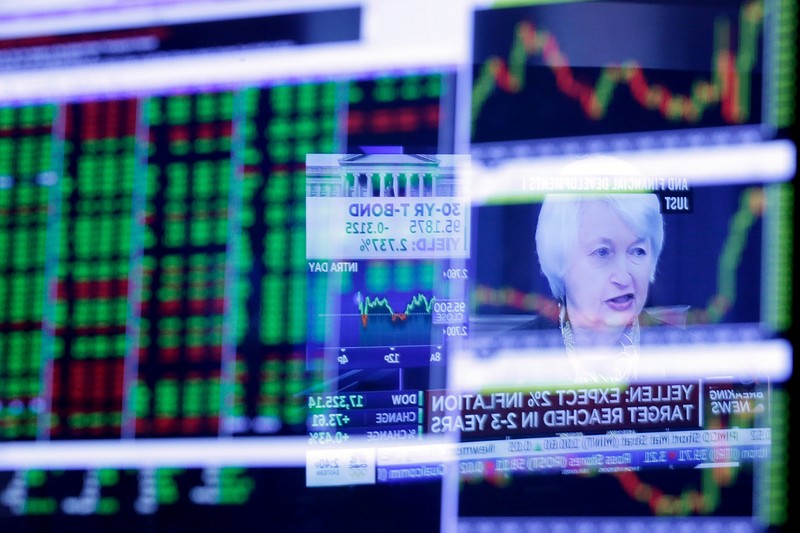WASHINGTON (AP) - On again. Off again.
On again?
Anyone trying to peg the likelihood of a Federal Reserve interest rate hike this year has been subject to a topsy-turvy shift of expert opinion the past few months. And when the Fed holds its latest policy meeting this week, few think it will provide much more clarity.
A few months ago, it was widely assumed that the Fed would have resumed raising rates by now. But that was before the U.S. government issued a bleak May jobs report and Britain's vote to quit the European Union triggered a brief investor panic. Since then, though, a resurgent U.S. economy, a bounce-back in hiring and record highs for stocks have led many economists to predict a Fed move by December if not sooner.
After its meeting ends Wednesday, the Fed will issue a statement that may point, in particular, to signs of a strengthened job market: In June, employers added 287,000 jobs, the most since October 2015. But the Fed will probably also acknowledge continued uncertainty about the consequences of Britain's exit from the EU. Most economists think the statement will remain mum about a timetable for the next rate hike.
Some think the Fed may decide to raise rates when it meets in September, especially if economic figures that emerge in the next couple of months show solid hiring and a rebound from a slump in economic growth early this year.
"We have just come through too much volatility for the Fed to be able to reach a definitive conclusion about raising rates in July, but by September they will have more data," said Sung Won Sohn, an economics professor at California State University, Channel Islands.
In December, the Fed raised its benchmark rate from a record low near zero, where it had stood since the depths of the 2008 financial crisis. It also laid out a timetable for up to four additional rate hikes this year. But as 2016 began, intensified fears about China's economy, the world's second-largest, and a plunge in oil prices sent markets sinking and led the Fed to delay any further action.
Once the markets stabilized, the Fed signaled a likely rate increase by midyear. Anemic hiring in April and May, though, raised concerns about the economy, and it left rates alone. The central bank was also affected by Britain's forthcoming vote on whether to leave the EU, anticipation of which had rattled investors.
When Britain did vote to leave the union and markets sank, some economists even suggested that the Fed's next move might be to cut, rather than raise, rates. Now, though, the pendulum has swung back, especially after the arrival of a reassuring June jobs report. The Standard & Poor's 500 stock index had plunged 5.3 percent in the two trading days after Britain's vote only to rebound 8.8 percent as of Friday's close.
The economy is also picking up after the year's anemic start. Stronger consumer spending is thought to have lifted growth, as measured by the gross domestic product, from a 1.1 percent annual rate in the January-March quarter to around 2.5 percent in the April-June quarter, with further acceleration expected later this year. In the spring, consumers boosted spending at the fastest pace in a decade. Economists also foresee a lift from business investment, reflecting a rebound from cutbacks in the energy sector.
All that strength might argue for September rate hike, especially if monthly job growth equals as least 200,000 between now and then. Still, the risks of raising rates again too soon and possibly choking off economic activity may seem greater to the Fed than the risks of waiting longer. It has room to accelerate its rate increases if the economy were to heat up so much as to ignite high inflation.
"If we get a couple of strong employment reports and some solid GDP numbers, they might decide to go in September, but my guess is that risk management concerns will persuade them to wait until the end of the year," said Mark Zandi, chief economist at Moody's Analytics.
But, Zandi added, "The slower they move rates this year, the faster they will have to raise rates in 2017 to play catch-up with a better economy."
According to data from the CME Group, investors foresee only about a 20 percent probability of a Fed rate hike by September and only about a 50-50 chance by December.
Diane Swonk, chief economist at DS Economics, said she thinks the Fed could wait until January given the uncertainty surrounding both the global outlook, including the threat of further terrorist attacks, and the outcome of the U.S. presidential election.
"The Fed is hedging its bets because it doesn't have lots of ammunition if things go wrong," Swonk said.
